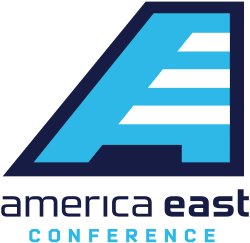University of New Hampshire
 | |
| Motto | Science, Arts, Industry |
|---|---|
| Type |
Public Flagship Sea grant Land grant Space grant |
| Established | 1866 |
| Endowment | $336 million[1] |
| President | James W. Dean Jr. |
Administrative staff | 586 |
| Students | 15,340[2] |
| Undergraduates | 12,840[2] |
| Postgraduates | 2,500 |
| Location | Durham, Concord, and Manchester, New Hampshire, U.S. |
| Campus |
Rural 2,600 acres |
| Colors |
Blue and White[3] |
| Athletics | NCAA Division I – America East, Hockey East |
| Nickname | Wildcats |
| Affiliations |
APLU NHCUC USNH |
| Mascot | Wild E. Cat |
| Website |
www |
 | |
The University of New Hampshire (UNH) is a public research university in the University System of New Hampshire, in the United States. The university's Durham campus, comprising six colleges, is located in the Seacoast region of the state. A seventh college, the University of New Hampshire at Manchester, occupies the university's campus in Manchester, the state's largest city. The University of New Hampshire School of Law, known as the Franklin Pierce Law Center until 2010, is located in Concord, the state's capital.
The University of New Hampshire was founded and incorporated in 1866, as a land grant college in Hanover in connection with Dartmouth College. In 1893, UNH moved to Durham.
With over 15,000 students between its Durham, Manchester, and Concord campuses, UNH is the largest university in the state. UNH is one of only a few universities that is designated a land-, sea-, and space-grant institution. The university's current President is James W. Dean Jr., the 20th President of the University, who took over from Mark Huddleston on June 30, 2018.[4]
History
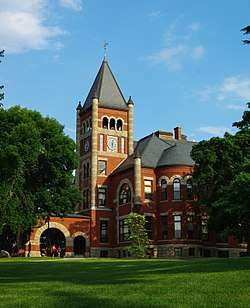

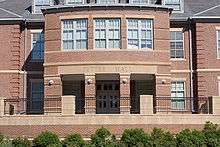
The Morrill Act of 1862 granted federal lands to New Hampshire for the establishment of an agricultural-mechanical college. In 1866, the university was first incorporated as the New Hampshire College of Agriculture and the Mechanic Arts in Hanover, New Hampshire, in association with Dartmouth College. The institution was officially associated with Dartmouth College and was directed by Dartmouth's president. Durham resident Benjamin Thompson left his farm and assets to the state for the establishment of an agricultural college. On January 30, 1890, Benjamin Thompson died and his will became public. On March 5, 1891 Gov. Hiram Americus Tuttle signed an act accepting the conditions of Thompson's will. On April 10, 1891, Gov. Tuttle signed a bill authorizing the college's move to Durham, New Hampshire.
In 1892, the Board of Trustees hired Charles Eliot to draw a site plan for the first five campus buildings: Thompson, Conant, Nesmith, and Hewitt Shops (now called Halls) and the Dairy Barn. Eliot visited Durham and worked for three months to create a plan prior to the move to Durham. The Class of 1892, excited about the pending move to Durham, held commencement exercises in an unfinished barn on the Durham campus. On April 18, 1892, the Board of Trustees voted to "authorize the faculty to make all the arrangements for the packing and removal of college property at Hanover to Durham." The Class of 1893, followed the previous class and held commencement exercises in unfinished Thompson Hall, the Romanesque Revival campus centerpiece designed by the prominent Concord architectural firm of Dow & Randlett.
In fall 1893, classes officially began in Durham with 51 freshmen and 13 upperclassmen, which was three times the projected enrollment. Graduate study was also established in fall 1893 for the first time. The number of students and the lack of state funds for dormitories caused a housing crunch and forced students to find housing in town. The lack of housing caused difficulty for attracting women to the university. In 1908, construction on Smith Hall, the first women's dorm, was completed using private and state funds. Prior to the construction of Fairchild Hall in 1915 for male students, 50 freshmen lived in the basement of DeMerritt Hall. With the continuing housing shortage for men, the administration encouraged the growth of the UNH Greek system. From the late 1910s through the 1930s, the fraternity system expanded and provided room and board for male students.
In 1923, Gov. Fred Herbert Brown signed a bill changing the name of the college to University of New Hampshire.
In the spring of 2015, the university was given $4 million from the estate of Robert Morin, who had been a librarian at the university for almost 50 years. Having lived a frugal and secluded life, he allowed for his life's savings to be given to the university without restraint.[5] In 2016, the news that the university was spending $1 million on a new video screen for the football stadium provoked criticism, on and off-campus, with critics noting that the difference between that amount and the $100,000 the university transferred to the library was jarring.[6][7][8] A story on Deadspin connected the money for the video screen to the amount of money spent on football and other sports at UNH, arguing that UNH had turned a small hobby of Morin's, watching football during the last months of his life, into an excuse to spend a quarter of his gift on a video screen.[9]
Academics
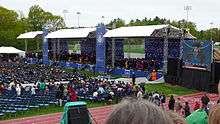
The University of New Hampshire is the flagship of the University System of New Hampshire. UNH is composed of eleven colleges and graduate schools, offering 2,000 courses in over 100 majors. The eight colleges of UNH are:
- College of Engineering and Physical Sciences (CEPS)
- College of Liberal Arts (COLA)
- College of Life Sciences and Agriculture (COLSA)
- Thompson School of Applied Science (TSAS)
- College of Health and Human Services (CHHS)
- University of New Hampshire at Manchester (UNHM)
- UNH Graduate School
- Peter T. Paul College of Business and Economics (PCBE), formerly the Whittemore School of Business and Economics (WSBE)
- University of New Hampshire School of Law
- Carsey School of Public Policy
- School of Marine Science and Ocean Engineering
The university is a member of the New England Board of Higher Education's New England Regional Student Program (NERSP) where New England public universities and colleges offer a number of undergraduate curricula with special considerations to students from other New England states. If an out-of-state student's home state school does not offer a certain degree program offered by UNH, that student can receive the in-state tuition rate, plus 75 percent if enrolled in the program.
The Thompson School of Applied Science (TSAS), first established in 1895 and now a division of COLSA, confers an associate degree in applied science in seven different programs: Applied Animal Science, Applied Business Management, Civil Technology, Community Leadership, Food Service Management, Forest Technology, and Horticultural Technology.
The coastal proximity of the university affords excellent programs in marine biology and oceanography. Facilities include the Jackson Estuarine Laboratory at Adams Point in Durham, and the Shoals Marine Laboratory jointly operated with Cornell University on Appledore Island in the Isles of Shoals.
The University of New Hampshire Observatory is operated by the Department of Physics for educational purposes.
There are three main university-wide undergraduate research programs: Undergraduate Research Opportunities Program (UROP), Undergraduate Research Fellowship (SURF), and International Research Opportunities Program (IROP).
The university offers many opportunities for students to study abroad through managed programs, exchange programs and approved programs. As of fall 2004, there were 561 students (4 percent of the student body) studying in 38 different countries. The university runs/manages 22 study abroad programs in locations which include Cambridge, England; London, England; Edinburgh, Scotland; Brest, France; Dijon, France; Grenoble, France; Budapest, Hungary; Osaka, Japan; Utrecht, Netherlands; Maastricht, Netherlands; Ascoli Piceno, Italy; New Zealand; India; South Africa; Kenya; and Granada, Spain. The university also accepts credit from over 300 approved programs that are run through other institutions. The university organizes an annual summer abroad program at Gonville and Caius College, Cambridge University. There are also over 100 National Exchange Program opportunities.
In 2010, the Franklin Pierce Law Center in Concord was incorporated into the University of New Hampshire System and renamed the University of New Hampshire School of Law. It is the only law school in the state of New Hampshire. The School of Law offers Juris Doctor degrees in addition to graduate studies in Intellectual Property and Commerce & Technology. The University of New Hampshire Law School is renowned for its intellectual property law programs, consistently ranking in the top ten of U.S. News & World Report rankings. In 2012, it was ranked 4th behind University of California at Berkeley, Stanford University and George Washington University.
The Peter T. Paul College of Business and Economics building was opened for occupancy in January 2013.[10] Formerly the Whittemore School of Business and Economics (WSBE), the Paul School offers degrees[11] in Business Administration (featuring focuses in Accounting, Entrepreneurial Venture Creation, Finance, Information Systems Management, International Business and Economics, Management, and Marketing), Hospitality, and Economics (either in B.A. or B.S.[11])
As of the 2015 fall semester, the university had 12,840 undergraduate students and 2,500 graduate students enrolled in more than 200 majors. The student body comprises 47% in-state students, 49% out-of-state students, and 4% international students; and is 54% female and 46% male.[12]
Rankings
| University rankings | |
|---|---|
| National | |
| ARWU[13] | 120-135 |
| Forbes[14] | 201 |
| U.S. News & World Report[15] | 107 |
| Washington Monthly[16] | 215 |
| Global | |
| ARWU[17] | 401-500 |
| QS[18] | 751-800 |
| U.S. News & World Report[19] | 486 |
U.S. News & World Report ranks New Hampshire (tied for) 107th among 280 "national universities."[20]
In 2012, the Department of Education ranked the University of New Hampshire as having the sixth most expensive in-state tuition for a public four-year college.[21] The University of New Hampshire ranks lowest in the country for the amount of subsidy it receives from the state.[22]
Research
The university is classified as one of the "Doctoral Universities: Higher Research Activity" in the Carnegie Classification of Institutions of Higher Education.
University library
The University Library consists of the main Dimond Library and three science libraries specializing in chemistry, physics, and computer science, mathematics, and engineering.[23] The Dimond Library has three quiet study reading rooms, seating for 1,200, Zeke’s Café, and the Dimond Academic Commons (DAC), in which is offered computer workstations, IT help, the Connors Writing Center, Geospatial Information Services Center, and research help. Other areas of the library provide access to media equipment, collaborative work spaces, and laptop ports.[24]
The Chemistry Library (Parsons Hall), the Engineering/Mathematics/Computer Science Library (Kingsbury Hall), and the Physics Library (DeMeritt Hall) offer customized service for the UNH scientific and engineering communities. Each science library offers specialized reference assistance, reserve materials, reference and circulating collections, periodicals, and electronic resources specific to their fields. All science libraries provide WiFi and laptop ports, laptops and computer workstations, as well as other equipment. Parsons, DeMeritt and Kingsbury Libraries have group meeting rooms that students may reserve; all have collaborative as well as quiet areas.
In addition to more than 2 million volumes and 50,000 periodical subscriptions, the library has an extensive government documents collection, maps, sound recordings, CDs, videos, DVDs, and a Special Collections and Archives section with rare books, manuscripts, and University publications and papers. The Library offers extensive electronic resources including e-books, digital collections, indexes in many subject areas, statistical data sets and databases supplying full-text periodical and newspaper articles.
University of New Hampshire InterOperability Laboratory (UNH-IOL)
Students and staff, mainly belonging to majors of Electrical Engineering, Computer Engineering, and Computer Science students work at the UNH InterOperability Laboratory, which tests networking and data communication devices and products. The UNH-IOL interviews and accepts applications from students of all majors and varying backgrounds of job experience and expertise.[25]
More than 100 graduate and undergraduate student employees work with full-time UNH-IOL staff, gaining hands-on experience with developing technologies and products. The companies and organizations that work with the UNH-IOL benefit from cost-effective testing services, as well as the opportunity to recruit future engineers from the UNH-IOL workforce.[26]
Carsey School of Public Policy
The Carsey School of Public Policy at the University of New Hampshire conducts policy research on vulnerable children, youth, and families and on sustainable community development. They give policy makers and practitioners the timely, independent resources they need to effect change in their communities.[27]
University demographics
| Header text | Number | Percentage |
|---|---|---|
| Undergraduates | 13,034 | 100% |
| Full Time Students | 12, 683 | 97% |
| Part Time Students | 353 | 3% |
| Graduate Students | 2,364 | NA |
| Male | 6,013 | 46% |
| Female | 7,021 | 54% |
| International Students | 298 | 2.28% |
| Students of Color | 1,120 | 9% |
| Hispanic/Latino | 431 | 3.3% |
| White | 10,409 | 79.86% |
| Average Age (First Year) | 18 | NA |
| Average Age (Undergraduate | 20 | NA |
Geographic origin (domestic)
| State | Students | Percentage |
|---|---|---|
| New Hampshire | 5,919 | 47% |
| Massachusetts | 3,643 | 27.94% |
| Connecticut | 778 | 5.96% |
| Maine | 470 | 3.6% |
| New York | 439 | 3.37% |
| New Jersey | 276 | 2.12% |
| Rhode Island | 271 | 2.08% |
| Vermont | 203 | 1.56% |
| Pennsylvania | 93 | .71% |
| Maryland | 52 | .4% |
Presidential commissions
As with many other universities, the office of the President at UNH has tasked several commissions to gather facts and propose solutions to various issues on campus. Many of these commissions deal with social issues on campus, such as the status of People of Color, People with Disabilities, and LGBTQ. These various commissions are staffed by administrators, faculty, and community members. The commissions meet monthly and report to the President, providing updates on the campus environment, suggesting and improving programs, and working with students, faculty, and outside organizations to improve the quality of life on campus.[29]
Student involvement
The university has more than 200 student organizations grouped by academics and careers, community service, political and world affairs, arts and entertainment, culture and language, fraternities and sororities, hall councils, honor societies, leisure and recreation, media and publications, religious, special interest, and student activism. Recreation at the University of New Hampshire also includes club and intramural sports. Student activities are largely funded by a Student Activity Fee, set in 2017 at $89 per year for full-time undergraduate students. The use and control of the Student Activity Fee are given by the University System of New Hampshire Board of Trustees to the Student Senate, and one of its subcommittees, the Student Activity Fee Committee.[30]
The New Hampshire Outing Club, the oldest and largest club on campus, offers trips into the outdoors each weekend. There is also a Dairy Club for people interested in dairy cows and learning more about them.[31]
Student government
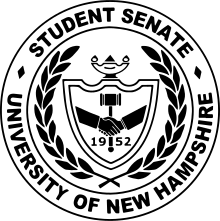
The Graduate Student Senate (GSS) represents all graduate students at UNH,[32] with senators elected from all colleges (College of Engineering & Physical Sciences, College of Liberal Arts, College of Life Sciences & Agriculture, College of Health & Human Sciences, Paul College of Business & Economics) as well as from the Graduate School and graduate housing.[33] The executive committee, composed of 6-7 members, includes a President, Vice President, Communications Officer, Financial Affairs Officer, External Affairs Officer, and Community Coordinator, with the most recent Past President serving at the discretion of the current President.[34] Senators and executive committee members serve on both internal and external committees, maintaining ties with other student organizations, as well as with the faculty and administration, in order to gather information and act on behalf of graduate student interests. GSS representation, elections, and other functions are governed by the UNH Graduate Student Senate Constitution & Bylaws.
The Student Senate of the University of New Hampshire is the on-campus, undergraduate student government. The Student Senate controls the use of the Student Activity Fee, and directly governs student organizations that receive a regular, annual budget from it. The Student Senate also formulates student stances on University policy, and attempts to lobby its position to administrators and the local and state government.[35] According to its Constitution, the Student Senate "[serves] as an advocate for all undergraduate students, deriving its power from the consent of the governed and developed on the principle that all undergraduate students of the University of New Hampshire have the right to participate in University governance. Such participation encourages the development of student expertise in University affairs and places significant responsibility on students for their involvement with the policies, rules, and regulations which affect the quality of education and the experience of students at the University of New Hampshire."[35]
The New Hampshire: The official UNH newspaper
The New Hampshire is UNH's weekly student newspaper. New issues appear every Thursday during the academic year.
Fraternity and sorority life
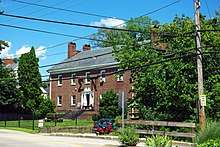
Approximately 14.6%[36] of undergraduate students are affiliated with fraternities and sororities recognized by the university. The Office of Student Involvement and Leadership, the Interfraternity Council (IFC) and Panhellenic Council (Panhel) oversee the 13 recognized social fraternities and eight recognized social sororities. Many of the fraternities and sororities have houses on Madbury Road and Strafford Avenue in Durham. These houses are not owned by or on university property.
|
Fraternities |
Sororities |
Professional fraternities |
Underrepresented students
Diversity Support Coalition
The student led Diversity Support Coalition (DSC) mission aims to offer resources to groups “affected by institutionalized oppression based on race, ethnicity, sexual orientation, sex, gender identity and expression, age, ability, native language, national origin, and/or religion at UNH”.[38]
The DSC promotes, educates, and supports multiculturalism, diversity, and equality at UNH through programming efforts and support of the six student organizations within the DSC. The six member groups are Alliance, The Black Student Union, Hillel, Mosaico, The Native American Cultural Association, and The United Asian Coalition. Participation in the DSC is open to all UNH students. The DSC encourages student organizations with similar needs be recognized under the Diversity Support Coalition and may due so by submitting a petition within the guidelines for the DSC constitution. The total membership of the DSC is 200 individuals.
In addition to the six organizations within the DSC, UNH students run over a dozen groups for the purpose of multiculturalism and peer reference groups. Groups include women in professional fields, country or geographic specific cultural clubs, and international student clubs.
Women
Multiple organizations on campus are focused on providing women in professional fields access to relational and ideational resources promoting success. Women focused groups on campus include Her Campus, UNH Data Driven Women, Women in Business, Society of Woman Engineers, and Women in Science.[39]
Cultural clubs
Culturally focused groups on campus include Desi Student Association, Japanese Cultural Club, Indonesian Student Association, International Student Organization Middle Eastern Cultural Association, Russian Cultural Club and Vietnamese Student Association. These groups often host events to educate the student body on their cultures and to welcome experts of ancestral crafts. Conversely, the Committee on Rights and Justice (CORAJ) partners UNH student's with local immigrant families, helping them with the naturalization process.
International students
The University instituted the Navitas program in 2011 to expand the amount of international students at the school. This expanded over the years into the Global Student Success Program (GSSP). The GSSP, in cooperation with the Office of International Students and Scholars (OISS), gives students the support to “help discover opportunities at UNH to immerse in American culture and share your own traditions with others from the U.S. and from around the globe”.[40] The programs guide students through the application process and the extent of their career.
During Fall 2015, UNH enrolled 298 Students from 34 different countries. The most common countries of origin are the People's Republic of China, Canada, and Vietnam.[41]
The school also offers intensive English language education for students through the ESL Institute. As well as advancing student’s knowledge of English as a second-language one of the goals of the ESL Institute is to “to provide students with the cultural knowledge and awareness needed to function satisfactorily, both academically and socially, in the United States”.[42] As of the 2015 year the university had almost 300 students representing the school from over 30 countries.
First-generation college students
Begun in 1994, UNH Connect is a program where FGCS (and multicultural students) are given a jump-start to the experiences of college life with a summer pre-orientation program aimed at social connection and comfortability with college life. Each student is assigned a peer mentor who helps with the transition to their freshman year. The program, with 100 students in 2014, also gives FGCS an opportunity to meet people in similar situations prior to the beginning of college.[43]
The Center For Academic Resources (CFAR) also offers a program called TRIO that is partially funded by the US Department of Education. TRIO is intended for students who are FGCS, have a disability, or are in extreme financial need. Through the TRIO program you can receive services to help understand options for future careers as well as advice with financial aspects of college most FGCS would not have home support with. These include academic tutoring, assistance with student loans, scholarship advise, individual counseling, career planning, and many more. In the 2017-18 school year the UNH TRIO program was funded for 200 students.[44]
Music
The University of New Hampshire offers two undergraduate degree programs: the Bachelor of Arts in music and the Bachelor of Music; and two graduate degree programs: the Master of Arts in music (concentrations in composition, conducting, and musicology), and the Master of Arts in teaching.
Athletics
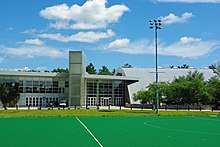
The school's athletic teams are the Wildcats, and they compete in the NCAA Division I. New Hampshire is a member of the America East Conference for basketball, cross country, track and field, soccer, swimming & diving and tennis; and women's lacrosse, crew, field hockey, and volleyball. The women's gymnastics[45] program competes in the Eastern Atlantic Gymnastics League at the Division I level. They also compete in Hockey East in men's and women's ice hockey, Eastern Collegiate Ski Association for skiing, as well as the Colonial Athletic Association for football at the Football Championship Subdivision (FCS, formerly known as Division I-AA) level.
In the 2006 academic year the university cut women's crew, men's swimming & diving, and men's and women's tennis at the varsity level, and trimmed the size of the men's ski team from 27 to 12. Luckily the UNH men's ski team was not cut, as they remain one of the top powerhouse teams in the nation. In 2013, the men's alpine team placed second at the NCAA championships. The reason given was that the athletic department would save $500,000 towards a $1 million budget shortfall and be in compliance with Title IX for the first time.[46] In 1997, the university cut baseball, softball, men's and women's golf, and men's lacrosse.
In addition to varsity athletics, the university offers many club sports through the Department of Campus Recreation, including aikido, archery, baseball, crew, cycling, dance, fencing, figure skating, golf, men's lacrosse, Nordic skiing, rugby, sailing, softball, tennis, taekwondo, men and women's Ultimate Frisbee,[47] wrestling, and the Woodsmen Club. Many of these clubs compete either on an intercollegiate basis with New England teams, or sponsor university tournaments and frequently participate in national championships. UNH also offers horseback riding as a recreation. Many students can take horseback riding lessons with instructors, on their horse or the schools. UNH holds many events each year, for they have a large cross country course. UNH also has a dressage team and a hunt seat team that competes yearly.
The school's official colors are blue and white. The school's official mascot is the wildcat and its uniformed mascot is known as "Wild E. Cat".
The recognized fight song of UNH is "On to Victory", the most current version of which was arranged by Tom Keck, Director of Athletic Bands from 1998–2003. In 2003, "UNH Cheer" (originally titled "Cheer Boys") was resurrected from the university archives by Erika Svanoe, Director of Athletic Bands from 2003-2006.[48] Based on the school song "Old New Hampshire", not to be confused with the New Hampshire state song of the same name, "UNH Cheer" currently serves as a secondary fight song and is often performed immediately following "On to Victory".
On October 7, 2006, Wildcats wide receiver David Ball tallied the 51st receiving touchdown of his career to displace Jerry Rice of Mississippi Valley State University, who was inducted into the College Football Hall of Fame a month earlier, atop the ranking of NCAA Division I and I-AA players by career receiving touchdowns. He later signed as a rookie free agent with the Chicago Bears and played with well-known college football players Chris Leak and Darius Walker.
Durham campus
The University of New Hampshire is located in the town of Durham, and is a "traditional New England campus." The Durham campus is 1,100 acres (4.5 km2), with 300 acres (1.2 km2) in the "campus core" and 800 acres (3.2 km2) of open land on the west edge of campus. The campus core is considered to be the university property within a 10-minute walk from Thompson Hall, the symbolic and near-geographic center of campus. The campus core contains many of the academic and residential buildings, while the outer campus contains much of the agriculture land and buildings. The university owns a total of 2,600 acres (11 km2) of land.
Housing
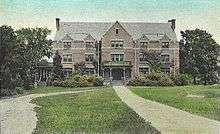
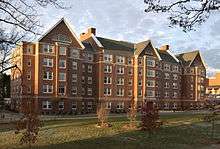

The university offers all underclassmen the opportunity to live in university housing. As of 2006, the university housed 55% of all undergraduate students. While not required to live on campus freshman year, students are strongly encouraged to; as of the fall 2009 semester over 99% of incoming freshmen chose to live on campus, and over 70% of returning sophomores did as well.
The university offers students a choice of traditional dorm rooms, suites, and on-campus apartments. The university's Campus Master Plan envisions housing about 60% of undergraduates, requiring an addition of 1700 beds. However, the state of New Hampshire does not provide funding for non-academically related buildings, including dormitories.
Undergraduate housing is divided into three areas: The Hills, The Valley and The Timbers (formerly Area I, Area II and Area III, respectively). There are also two undergraduate apartment complexes, The Gables and Woodside Apartments. The university offers family housing in the Forest Park apartments and graduate housing in Babcock Hall. The second oldest dorm on campus is Hetzel Hall, named after the university's former president Ralph D. Hetzel. Built in 1925, it is located near downtown Durham.
For the fall 2006 semester, two new buildings at The Gables ("North" and "South") were opened, providing an additional 400 beds. In summer 2006, one-half of Forest Park was demolished to make way for two new buildings (A & B) of the Southeast Residential Community (SERC). Buildings SERC A and SERC B have provided housing for 492 students since fall 2007. Two existing mini-dorms were demolished during summer 2007 (leaving four more mini-dorms) to construct a third building, SERC C, which has provided housing for 235 students since fall 2008. SERC A, B, and C are now referred to as Handler, Peterson, and Haaland Hall. Plans exist to provide 781 new beds by demolishing the remaining 9 buildings (98 units) in Forest Park. Later plans call for the construction of a new 170-unit graduate housing facility at a location to be determined.
Due to the over-enrollment of the 2006–2007 academic year, the university offered students who intended to live in campus housing a free parking pass for the academic year, credit in UNH "Dining Dollars" and a refund of the housing deposit given that the student withdrew their intentions to live on campus. The incentive was designed to free up space for the large incoming freshman class.
Stoke Hall is the largest residence building on campus. It houses a little over 700 undergraduate students.[49]
In 2015, UNH installed life-saving automated external defibrillators in two fraternity houses.[50]
Themed housing
The University of New Hampshire offers themed housing options for students interested in choosing a living environment that best suits their personality. Common themes include: first year, leadership, green living, multi-cultural, honors, chem-free, alcohol and drug-free and the arts.[51]
Housing is guaranteed to all new first-year students, with many of them housed in Christensen Hall and Williamson Hall, the two largest first-year-only halls. Alexander Hall is also an all first-year student hall, specifically for students in the College of Liberal Arts who have not declared a major yet.[52] These halls offer a living environment of commonality, where all are new to the university. The university guarantees students who live on-campus the ability to live on campus all four years. However, students who move off campus (with the exception of students studying abroad) lose this guarantee, and must complete a housing wait-list application each semester in order to be considered for on-campus housing the following semester.[53]
Transfer students can generally get on campus housing if transferring to UNH for the spring semester (but must submit a completed housing wait-list application prior to transferring);[53] however, transfer students transferring for the fall semester have a relatively low chance of getting on campus housing due to the high demand of returning students, and the incoming freshman class. Transfer students are also not guaranteed housing, unless transferring from a community college after graduating with their associates.[53]
Manchester campus


As of March 2015, University of New Hampshire at Manchester is located in the 110,000-square-foot (10,000 m2) Pandora Mill at 88 Commercial Street, on the banks of the Merrimack River in Manchester's historic Amoskeag Millyard. The move to 88 Commercial Street increased the physical plant of the college by almost 50%, as from 2001 to 2014 the school was located in the 75,000-square-foot (7,000 m2) University Center building at 400 Commercial Street.
National Historic Chemical Landmark
Conant Hall was dedicated as a National Historical Chemical Landmark—the first in New Hampshire. Conant Hall was the first chemistry building on the Durham campus, and it was the headquarters of the American Chemical Society from 1907–1911, when Charles Parsons was the society’s secretary. In addition, from 1906–1928, the hall housed the laboratories of Charles James, who was an innovative developer of separation and analytical methods for compounds of rare earth elements.[54] James Hall, the second chemistry building on campus, was named for Charles James.
Notable alumni
Notable alumni of the University of New Hampshire include world-renowned author John Irving (B.A. 1965), National Book Award-winning author Alice McDermott (M.A. 1968), filmmaker Jennifer Lee (B.A. 1992) and several former governors of the state of New Hampshire.
Notable faculty
- Grant Drumheller, painter, professor of art
- Meredith Hall, author of New York Times bestseller Without a Map, lecturer of English
- Jochen Heisenberg, professor emeritus of physics, son of famed German physicist and Nobel laureate Werner Heisenberg
- Rochelle Lieber, linguist, professor of English
- John D. Mayer, professor of psychology, co-developer of Mayer-Salovey-Caruso Emotional Intelligence Test (MSCEIT) and notable author and expert on personality psychology
- Joshua Meyrowitz, author of No Sense of Place, professor emeritus of communication
- Robert Morin, Dimond Library cataloger who donated his four million dollar estate to the university after his death in 2015
- Donald Murray, Pulitzer Prize-winning journalist, professor emeritus of English
- Lori Robinson, general in the USAF, first female commander of North American Aerospace Defense Command (NORAD)
- Edwin Scheier, sculptor, fine art professor emeritus
- Mary Scheier, sculptor, artist-in-residence emeritus
- Charles Simic, Pulitzer Prize-winning poet, professor of English, U.S. Poet Laureate (2007–08)
- Clark Terry, jazz trumpeter, affiliate faculty, Department of Music (1988-2015)[55]
- Stacy D. VanDeveer, political scientist, professor of political science and chair of the Department of Political Science
- Yitang Zhang, number theorist, professor of mathematics, MacArthur Fellow
Campus sites of interest
- Durham–UNH station, historic train depot, home of UNH Dairy Bar[56]
- Jesse Hepler Lilac Arboretum
- UNH Museum of Art[57]
- Whittemore Center, home to UNH Wildcat men's and women's hockey. Capacity is 6,501 for sporting events, 7,500 for concerts and other events.
- Lundholm Gym, home to UNH Wildcat men's and women's basketball and women's gymnastics
- Wildcat Stadium, home to UNH Wildcat football
- Thompson Hall, first structural home of the University of New Hampshire[58]
- Memorial Union Building (MUB)
See also

- UNH Alma Mater
References
- ↑ http://usnews.com/best-colleges/university-of-new-hampshire-2589
- 1 2 "About UNH". Retrieved January 11, 2016.
- ↑ "Visual Identity Standards" (PDF). October 28, 2015. Archived from the original (PDF) on March 28, 2016. Retrieved April 9, 2016.
- ↑ "James W. Dean Jr. Named 20th President of the University of New Hampshire p". April 3, 2018. Retrieved April 10, 2018.
- ↑ "Long-Time Librarian Surprises UNH with $4 Million Gift". August 30, 2016. Retrieved March 24, 2018.
- ↑ "$1 Million Of Frugal Librarian's Bequest To N.H. School Goes To Football Scoreboard". Retrieved March 24, 2018.
- ↑ "'A very unusual' librarian donated his entire $4 million estate to his university upon his death — and it spent $1 million on a football scoreboard". Retrieved March 24, 2018.
- ↑ "Critics question spending librarian's donation on scoreboard". Retrieved March 24, 2018.
- ↑ Fehrman, Craig. "How UNH Turned A Quiet Benefactor Into A Football-Marketing Prop". Retrieved March 24, 2018.
- ↑ "Paul College of Business and Economics". University of New Hampshire. Archived from the original on 2013-04-10.
- 1 2 "Undergraduate Course Catalog". University of New Hampshire. Retrieved April 2, 2013.
- ↑ "Demographics". University of New Hampshire Institutional Research. Archived from the original on December 24, 2015. Retrieved November 10, 2015.
- ↑ "Academic Ranking of World Universities 2017: USA". Shanghai Ranking Consultancy. Retrieved August 29, 2017.
- ↑ "America's Top Colleges". Forbes. July 5, 2016.
- ↑ "Best Colleges 2017: National Universities Rankings". U.S. News & World Report. September 12, 2016.
- ↑ "2016 Rankings - National Universities". Washington Monthly. Retrieved September 6, 2016.
- ↑ "Academic Ranking of World Universities 2017". Shanghai Ranking Consultancy. 2017. Retrieved August 29, 2017.
- ↑ "QS World University Rankings® 2018". Quacquarelli Symonds Limited. 2017. Retrieved 25 July 2017.
- ↑ "Best Global Universities Rankings: 2017". U.S. News & World Report LP. Retrieved October 25, 2016.
- ↑ "University of New Hampshire | Best College | US News". U.S. News & World Report. Retrieved November 18, 2015.
- ↑ Kingkade, Tyler (June 12, 2012). "Public 4-Year Colleges with the Highest Tuition: Dept. of Education 2012 List". Huffingtonpost.com. Retrieved November 22, 2012.
- ↑ "New Hampshire State Budget". Sunshine Review. Sunshine Review. Archived from the original on April 23, 2013. Retrieved March 26, 2013.
- ↑ "University Library".
- ↑ Guarino, Ben (September 16, 2016). "University to buy $1 million football scoreboard with thrifty librarian's money, outraging critics". Washington Post. Retrieved September 16, 2016.
- ↑ "InterOperability Laboratory: About Us". Iol.unh.edu. Retrieved July 6, 2012.
- ↑ "InterOperability Laboratory: About Us". Iol.unh.edu. Retrieved January 26, 2011.
- ↑ "The Carsey Institute: About Us". carseyinstitute.unh.edu. Retrieved November 5, 2013.
- ↑ "Undergraduate Profile" (PDF). University of New Hampshire Office of Admissions. University of New Hampshire. Archived from the original (PDF) on August 10, 2016. Retrieved May 1, 2018.
- ↑ "Status of Women". Community, Equity and Diversity. July 13, 2017. Archived from the original on March 26, 2018. Retrieved May 1, 2018.
- ↑ "Wildcat Link: Student Activity Fee Committee". Archived from the original on November 12, 2017. Retrieved November 12, 2017.
- ↑ "Dairy Club". Wildcat Link. Archived from the original on September 7, 2015. Retrieved November 12, 2015.
- ↑ "Graduate Student Senate". University of New Hampshire. June 11, 2013. Retrieved October 15, 2017.
- ↑ "Executive Committee & Senators". University of New Hampshire. June 12, 2013. Retrieved October 15, 2017.
- ↑ "Structure & Representation". University of New Hampshire. June 12, 2013. Retrieved October 15, 2017.
- 1 2 "Student Senate Constitution" (PDF). University of New Hampshire Student Senate. October 31, 2017. Retrieved November 17, 2017.
- ↑ "Chapters". Archived from the original on March 29, 2013. Retrieved April 2, 2013.
- ↑ Wright, Lori. "UNH Alpha Phi Omega: Dedicated to Service and Leadership". UNH Today. Archived from the original on January 6, 2016. Retrieved November 12, 2015.
- ↑ "Diversity Support Coalition". WildcatLink. Archived from the original on April 27, 2018. Retrieved April 26, 2018.
- ↑ https://www.unh.edu/career/career-resources-women
- ↑ https://www.unh.edu/global/international-students
- ↑ "Undergraduate Profile" (PDF). University of New Hampshire Office of Admissions. University of New Hampshire. Archived from the original (PDF) on August 10, 2016. Retrieved May 1, 2018.
- ↑ https://cola.unh.edu/esl-institute/mission-statement
- ↑ https://www.unh.edu/orientation/connect/about-us
- ↑ https://www.unh.edu/cfar/triostudent-support-services
- ↑ women's gymnastics
- ↑ Archived February 19, 2006, at the Wayback Machine.
- ↑ Johnson, Cameron (November 7, 2014). "Ultimate Frisbee: Sisters of Oriza: A look inside women's Ultimate". The New Hampshire. Archived from the original on October 12, 2015. Retrieved November 12, 2015.
- ↑ "Professional Experience". ErikaSvanoe.com. Retrieved November 12, 2015.
- ↑ "Stoke Hall". University of New Hampshire Housing & Residential Life. Retrieved November 12, 2015.
- ↑ "UNH installs AEDs in fraternity houses". WMUR. Retrieved November 10, 2015.
- ↑ "Living on Campus – Theme Living Communities". University of New Hampshire Housing & Residential Life. Retrieved January 26, 2011.
- ↑ "Alexander Hall". University of New Hampshire Housing & Residential Life. Retrieved November 12, 2015.
- 1 2 3 "UNH Housing Waitlist Process". Unh.edu. February 29, 2012. Archived from the original on July 1, 2012. Retrieved July 6, 2012.
- ↑ ACS National Historic Chemical Landmark, Separation of Rare Earth Elements (1999).
- ↑ Feeney, Mark (February 23, 2015). "Clark Terry, at 94; one of jazz's top trumpet players, personalities". The Boston Globe. Retrieved November 12, 2015.
- ↑ "Dairy Bar". University of New Hampshire Dining. Retrieved November 12, 2015.
- ↑ "Museum of Art". University of New Hampshire College of Liberal Arts. Retrieved November 12, 2015.
- ↑ "Thompson Hall Clocktower from the Inside Out". UNH Today. Archived from the original on January 8, 2016. Retrieved November 12, 2015.
External links
| Wikimedia Commons has media related to University of New Hampshire. |
| Wikisource has the text of the 1921 Collier's Encyclopedia article New Hampshire College. |
Coordinates: 43°08′08″N 70°56′00″W / 43.13556°N 70.93333°W
